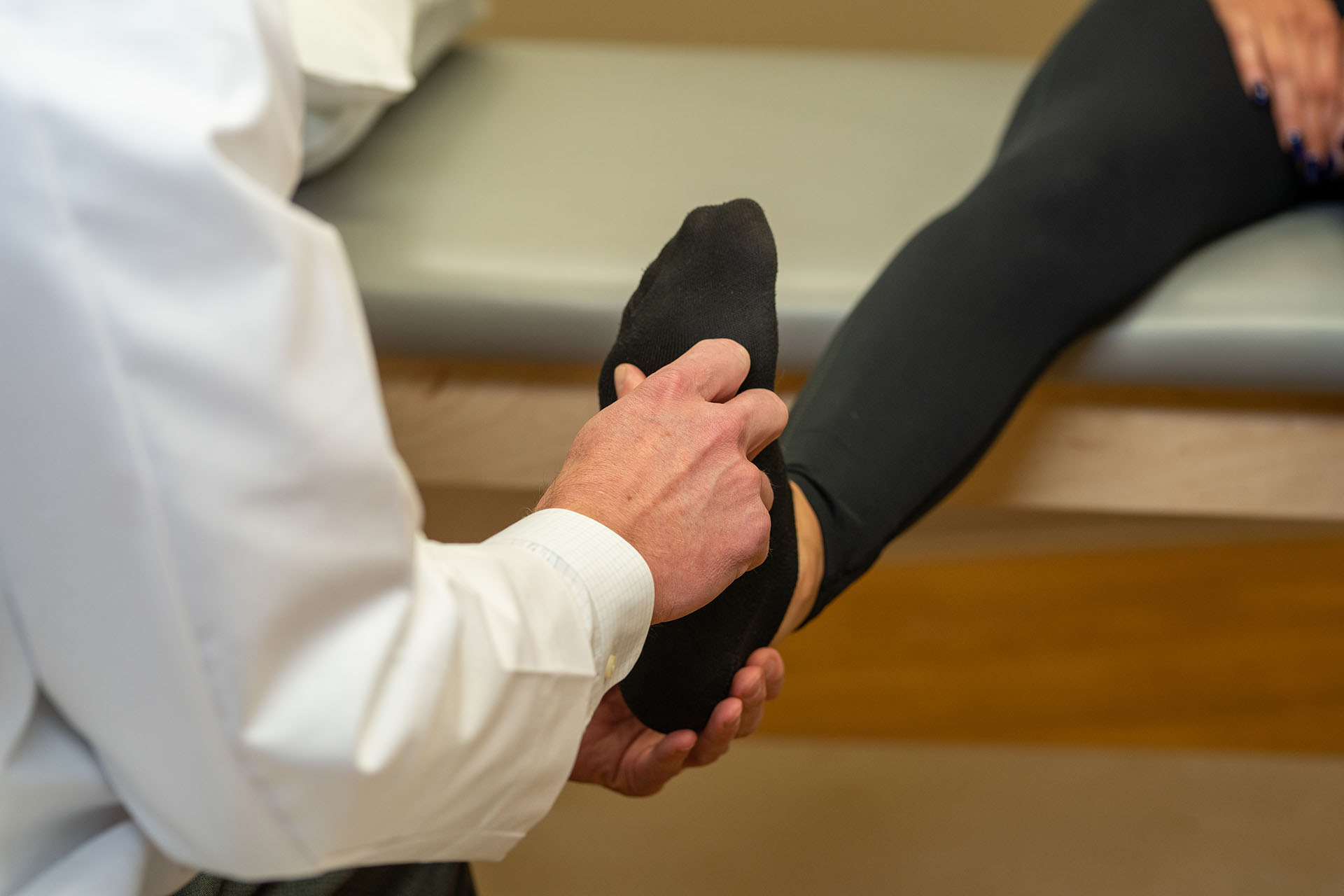Are you suffering from potential Peroneal Tendon Tears?
The Omaha Foot & Ankle Specialists at MD West ONE are able to properly diagnose and treat Peroneal Tendon Tears through both surgical and non-surgical treatments. If you have the following symptoms, you may want to make an appointment with one of our Board Certified Specialists.
- Ankle pain along the length of your tendon
- Pain that gets worse with physical activity
- Swelling, redness or warmth around your tendon
- Thickened tendons, with a mass or nodule that moves with your tendon
Meet MD West ONE's foot and ankle specialists and learn more about how they treat Peroneal Tendon Tears.

Kathleen A. Grier, M.D.
Foot & Ankle Specialist

David J. Inda, M.D.
Foot & Ankle Specialist

Scott T. McMullen, M.D.
Foot & Ankle Specialist

Shane Schutt, M.D.
Foot & Ankle Specialist
Peroneal Tendon Tears Causes, Treatments & Surgery
What is Peroneal Tendon Tears?
Peroneal tendonitis is inflammation in the tendons that run along your outer ankle bone and the side of your foot. These tough bands of tissue connect the muscles in your lower leg to the bones in your foot. They help stabilize and balance your foot and ankle, protecting them from injuries.
This type of foot tendonitis is usually the result of overuse, but it can also happen suddenly if you fall or injure your foot.
The following factors put you at an increased risk for Peroneal Tendon Tears:
- Are over 40.
- Do not stretch before physical activity.
- Have certain conditions, such as diabetes, osteoarthritis, rheumatoid arthritis, or gout.
- Have had previous tendon injuries.
- Have high arches in your feet.
- Are overweight/obesity.
- Have tight tendons.
- Smoke.

Ways to Decrease Your Risk of Developing Peroneal Tendon Tears:
- Gradually work up to intense physical activity.
- Maintain a healthy body weight.
- Never push through foot or ankle pain.
- Quit smoking.
- Allow for rest between workouts, games, or other physical activity.
- Stretch to warm up your feet and ankles before physical activity.
- Use ankle braces, supportive shoes, or other appropriate protective equipment.
- Wear orthotics if you have high arches, but only if recommended by your healthcare provider.

Diagnosis
Peroneal tendonitis can be difficult to diagnose. The symptoms are similar to those of other foot and ankle problems, like sprains, arthritis, and fractures. One study suggests that out of 40 people with peroneal tendonitis, about 60% were initially misdiagnosed.
Your healthcare provider will perform a physical exam and review your symptoms, though. They may palpate (press) on certain parts of your foot and ankle to check for swelling or tenderness. Your provider might also ask you to perform certain ankle movements to evaluate the range of motion in the joint.
Sometimes imaging is necessary to make sure you do not have a foot fracture, osteoarthritis, cartilage damage or torn tissue. Your provider might recommend an X-ray, MRI, CT scan, or ultrasound, as well.
Non-Surgical Treatment Options
Conservative treatments usually help relieve tendon pain and inflammation within three to four weeks. Recovery might take longer if tendonitis is the result of another injury, such as a sprain.
Common treatments for peroneal tendonitis include:
- Bracing: An ankle brace can support and stabilize your ankle if you have to perform certain movements, like running or jumping.
- Immobilization: You might need a soft cast or boot to immobilize your foot and take weight off your tendons so they can heal.
- Medication: Non-steroidal anti-inflammatory drugs (NSAIDs) can reduce pain and inflammation. In some cases, your provider might recommend steroid injections around the tendon itself, into the tendon sheath.
- Physical therapy: Physical therapists guide you through exercises and stretches to regain strength and flexibility in your foot and ankle. Your therapist might also recommend ice, heat, or ultrasound therapy.
- RICE method: You can perform RICE (rest, ice, compression and elevation) at home. Rest by avoiding strenuous activities. Apply an ice pack or cold compress to your ankle for 20 minutes every two hours. Wrap your ankle in a compression bandage to reduce swelling and keep your ankle elevated, preferably above the level of your heart.
Surgical Treatment Options
If peroneal tendonitis does not improve with conservative treatments, you might need surgery. Surgery consists of cleaning out the damaged outer layers of tissue from your peroneal tendons during a procedure called a synovectomy. Some people may be candidates for a minimally invasive synovectomy, which involves smaller incisions (cuts) and a faster recovery.
Frequently Asked Questions?
Peroneal tendonitis is not as common as other types of foot tendonitis, such as Achilles tendonitis. In one study of several thousand runners, there were only 13 cases (less than 1%) of peroneal tendonitis.
Peroneal tendon inflammation can develop over time with repetitive overuse of the tendons. Or it might happen suddenly due to an acute ankle injury like a sprain. The tendons or the lubricated sheath that surrounds the tendons can swell, making it hard for them to move smoothly.
Like all surgeries, ankle surgery for peroneal tendonitis does carry some risks such as:
- Bleeding.
- Blood clots.
- Infection.
- Nerve damage.
- Recurring tendonitis or ankle pain.
- Scar tissue formation.
American Orthopaedic Foot & Ankle Society
All of the foot and ankle surgeons in the practice are recognized members of the American Orthopaedic Foot & Ankle Society. It is the oldest and most prestigious medical society dedicated to the foot and ankle. The mission of the society is to advance science and practice of foot and ankle surgery through education, research, and advocacy on behalf of patients and practitioners. These physicians dedicate their time and energy to improving the patient experience and their knowledge in their field. For more information visit http://www.aofas.org.
MD West ONE Foot & Ankle Specialists:
The Foot & Ankle Specialists are all Board Certified and Fellowship-Trained, meaning they’ve focused their education, training and research on orthopaedic surgery of the foot and ankle.
